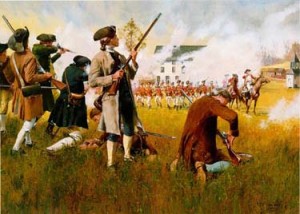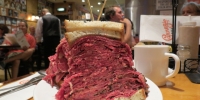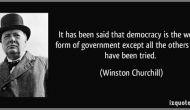 The problem with many of the current attempts to interpret the Second Amendment is that nothing in it actually applies to the arguments we’re having today. Can individuals own guns? If so, which individuals, which guns, for what purpose, and how many? Can governments control the buying and selling of guns? If so, should that be done by the States or the Feds? Both? Neither?
The problem with many of the current attempts to interpret the Second Amendment is that nothing in it actually applies to the arguments we’re having today. Can individuals own guns? If so, which individuals, which guns, for what purpose, and how many? Can governments control the buying and selling of guns? If so, should that be done by the States or the Feds? Both? Neither?
The Framers said nothing in the Constitution or in the Bill of Rights that speaks to any of that because they weren’t thinking about any of that. In their time, guns were accepted as a part of life, same as shoes. There was hunting to do if one was to eat, there were Indians to fend off if one was to survive, there was land to grab away from said Indians if — well, that’s another story.
At the time of the Constitutional Convention in May of 1787, the Framers had their own problems to deal with, and they had nothing to do with the buying and selling of guns. The Articles of Confederation were not working. The Federalists saw the need for a stronger central government. They wanted a Constitution and they were willing to compromise to get it. One significant example of the need for a stronger central government still present in their minds was that while Washington begged for an army adequate to the defense of the new nation against the British, state militias showed up or not on whim, with or without sufficient training. And no one had the power to do anything about that. Another, more immediate example was Shays’ Rebellion of 1786. A complex uprising in western Massachusetts, it was seen as a threat to the young country’s existence and could not be put down by the available local militias.
The anti-Federalists feared too strong a central government. They – and the Federalists as well – bore the memory of Britain’s standing army in the colonies, an army that confiscated Revolutionary arms in Concord. Many of the Framers had a hand in the Declaration of Independence’s assertion that citizens must be prepared to overthrow any and all tyrannical governments. Hence, while the Federalists had good reason to want to centralize power, the States had equally good reason to want control over their own militias. (That those militias were sometimes indistinguishable from slave patrols in the Southern states is true, but the perceived need for state militias went well beyond this one use.)
An agreement was worked out. In simple terms: They all accepted the fact that the country needed armed and well-regulated militias available on call to serve in the national interest, “to insure domestic tranquility” and “provide for the common defense.” They all understood that there were States that would not agree to a nationally-controlled militia. To push the Constitution through, the approval of those States was necessary. So the deal was that the States would train, officer, and maintain their own well-regulated militias, but would make them available nationally as needed. The national government, in turn, would have no power to mess with State control of those militias by calling them up for duty and then disbanding or disarming them from on high.
The Framers fussed with the language: “Father of the Constitution” James Madison’s early wording read, “The right of the people to keep and bear arms shall not be infringed; a well armed and well regulated militia being the best security of a free country, but no person religiously scrupulous of bearing arms shall be compelled to render military service in person.” The eventually accepted version stated, “As a well regulated militia, being necessary to the security of a free state, the right of the people to bear arms shall not be infringed.”
The right to “keep arms” referred to owning them, while the right to “bear arms” referred to carrying them in the context of serving in a well regulated militia. Why were the rights to “keep arms” and the rights of conscientious objectors stricken from the final version? We don’t know for sure, but it’s likely there was no perceived need for them in the solving of the problems of that time. The deal being worked out was between the federal government and the States, not government and individual citizens.
The placement of the deal was also debated. The Constitution spelled it out in Section 8, Articles 15 and 16. Madison thought that was enough, and that any problems that came up with that issue and others would be worked out over time through the ingenious system of checks and balances already inherent in the Constitution itself. But wary anti-Federalists wanted more absolute confirmation of who could and should, who couldn’t and wouldn’t, do what and to whom. Eager for the Constitution to pass, the Framers agreed to add the Bill of Rights, including the Second Amendment.
Our current National Guard is an offshoot of the militias of that era. The States run their own units and provide them for national purposes when called upon to do so. The national government cannot disband or disarm those units.
So what in all that debate about, compromise on, and final wording of the Second Amendment says anything as to where the arms should come from and who should have the right to buy them, sell them, collect them, or trade them – or what types of arms might or might not be borne and for what purposes other than well-regulated militias? Nothing. Not even one word about hunting. Or crime-fighting. Or skeet shooting.
Nothing. Not their problem.
Ours.
Harvey Asher
After receiving his doctorate from Indiana University, Harvey Asher taught a variety of courses in history and interdisciplinary studies for thirty-five years at Drury University, a liberal arts school in Springfield, Missouri. His articles on themes in Russian history, American history, and the Holocaust have appeared in the Russian Review, Kritika, the Journal of Genocide Research, the Russian Dictionary, the SHARF Newsletter, Federalism in America: An Encyclopedia, and Lessons and Legacies of the Holocaust. He is also the author of The Drury Story Continues, an informal but thorough history of the school.


![Let's Go to Chinatown, Shall We? [PHOTOS]](https://sheamagazine.com/wp-content/plugins/special-recent-posts-pro/cache/MjAwMTAwbm9jaGluYXRvd24tMi1idy0=.jpg)



![Let's Go to the Empire State Building - Shall We? [PHOTOS]](https://sheamagazine.com/wp-content/plugins/special-recent-posts-pro/cache/MjAwMTAwbm9JTUdfMzkxNjE=.jpg)



![Scenes from Washington Square Park - NYC [PHOTOS]](https://sheamagazine.com/wp-content/plugins/special-recent-posts-pro/cache/MjAwMTAwbm9JTUdfNDA1Mg==.jpg)
![Sunset - Pelham Shore Park - Long Island Sound [PHOTOS]](https://sheamagazine.com/wp-content/plugins/special-recent-posts-pro/cache/MjAwMTAwbm9JTUdfMzM3MC1SRVNJWkU=.jpg)






